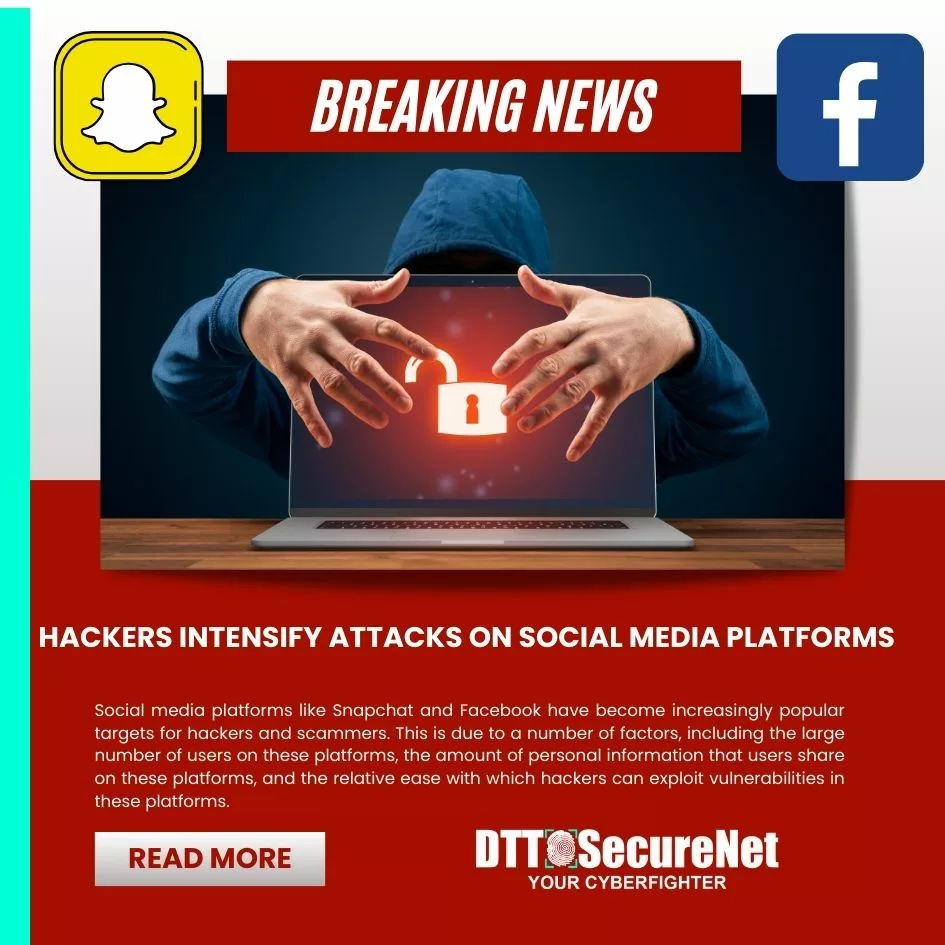Hackers on Snapchat
Learn how to prevent social media scams and to avoid hackers on Snapchat, Facebook, LinkedIn and other social media platforms.

About
How to Prevent Hackers on Snapchat
Social media platforms like Snapchat and Facebook have become increasingly popular targets for hackers and scammers. This is due to a number of factors, including the large number of users on these platforms, the amount of personal information that users share on these platforms, and the relative ease with which hackers can exploit vulnerabilities in these platforms.
Some of the most common types of attacks on social media platforms include:
Phishing attacks: Phishing attacks involve sending fraudulent emails or text messages that appear to be from a legitimate source, such as a social media company or a bank. These messages often contain links to fake websites that are designed to steal users’ personal information, such as their usernames, passwords, and credit card numbers.
Malware attacks: Malware attacks involve tricking users into downloading and installing malicious software on their devices. This malware can then be used to steal users’ personal information, spy on their activities, or even take control of their devices.
Account takeovers: Account takeovers involve hackers gaining access to users’ social media accounts. Once they have access to an account, hackers can use it to post spam, send malicious messages to the user’s friends and followers, or even steal the user’s identity.
Social media users can protect themselves from these attacks by being aware of the risks and taking steps to protect their accounts. Some tips for protecting yourself from social media attacks include:
Be careful about what links you click on and what attachments you open.
Use strong passwords and enable two-factor authentication on all of your social media accounts.
Be careful about what information you share on social media.
Keep your social media software up to date.
If you think that your social media account may have been hacked, you should immediately change your password and enable two-factor authentication. You should also contact the social media platform to report the hack.

Hackers on Social Media and Snapchat
Social media platforms like Snapchat are increasingly becoming targets for hackers and scammers. This is due to a number of factors, including the large number of users on these platforms, the amount of personal information that users share on these platforms, and the relative ease with which hackers can exploit vulnerabilities in these platforms.
Hackers on Social Media
Hackers use a variety of methods to attack social media users. Some of the most common methods include:
- Phishing attacks: Phishing attacks involve sending fraudulent emails or text messages that appear to be from a legitimate source, such as a social media company or a bank. These messages often contain links to fake websites that are designed to steal users’ personal information, such as their usernames, passwords, and credit card numbers.
For example, a hacker might send a Snapchat user an email that appears to be from Snapchat Support. The email might say that the user’s account has been compromised and that they need to click on a link to reset their password. If the user clicks on the link, they will be taken to a fake Snapchat website that is designed to steal their username and password.
- Malware attacks: Malware attacks involve tricking users into downloading and installing malicious software on their devices. This malware can then be used to steal users’ personal information, spy on their activities, or even take control of their devices.
For example, a hacker might create a fake Snapchat app that contains malware. When a user downloads and installs the fake app, the malware will be installed on their device. The malware can then be used to steal the user’s Snapchat account information, spy on their Snapchat activity, or even take control of their Snapchat account.
- Account takeovers: Account takeovers involve hackers gaining access to users’ social media accounts. Once they have access to an account, hackers can use it to post spam, send malicious messages to the user’s friends and followers, or even steal the user’s identity.
For example, a hacker might use a phishing attack to steal a Snapchat user’s username and password. Once they have the user’s login information, they can log in to the user’s account and take control of it. The hacker can then use the account to post spam, send malicious messages to the user’s friends and followers, or even steal the user’s identity.
Hackers on Snapchat
Hackers use the same methods to attack Snapchat users as they do to attack users of other social media platforms. However, there are a few specific types of attacks that are more common on Snapchat.
One common type of attack on Snapchat is the Snapchat sextortion: Snapchat sextortion involves hackers threatening to release intimate photos or videos of Snapchat users unless they pay a ransom. Hackers often obtain these photos and videos by hacking into users’ Snapchat accounts.
Another common type of attack on Snapchat is the Snapchat phishing attack: Snapchat phishing attacks involve hackers sending fraudulent emails or text messages that appear to be from Snapchat Support. These messages often contain links to fake Snapchat websites that are designed to steal users’ personal information, such as their usernames, passwords, and credit card numbers.
Examples of Hacker Attacks on Social Media and Snapchat
Here are a few examples of hacker attacks on social media and Snapchat that have occurred in recent years:
- In 2014, hackers stole the usernames and phone numbers of over 4.6 million Snapchat users and posted the data online.
- In 2018, hackers used a phishing attack to steal the login credentials of over 6 million Facebook users.
- In 2019, hackers used a malware attack to steal the Snapchat account information of over 4.6 million users.
- In 2020, hackers used a sextortion attack to target Snapchat users in the United States and Canada.
How to Protect Yourself from Hackers on Social Media and Snapchat
There are a number of things you can do to protect yourself from hackers on social media and Snapchat, including:
- Be careful about what links you click on and what attachments you open.
- Use strong passwords and enable two-factor authentication on all of your social media accounts.
- Be careful about what information you share on social media.
- Keep your social media software up to date.
If you think that your social media account may have been hacked, you should immediately change your password and enable two-factor authentication. You should also contact the social media platform to report the hack.

Here are some additional tips for protecting yourself from hackers on Snapchat:
- Be careful about who you add as friends. Only add people you know and trust.
- Don’t share your Snapchat username or phone number with people you don’t know.
- Be careful about what snaps you send. Don’t send snaps that you wouldn’t want to be made public.
- Be careful about what links you click on in snaps.
- Be careful about what third-party Snapchat apps you use. Only use apps from trusted developers.
- Keep your Snapchat app up to date.
If you think that your Snapchat account may have been hacked, you should immediately change your password and enable two-factor authentication. You should also contact Snapchat Support to report the hack.
Here are some additional tips for avoiding Snapchat sextortion attacks:
- Never send explicit photos or videos to anyone on Snapchat, even if you think you know them.
- If someone threatens to release explicit photos or videos of you, don’t pay them any money. Instead, report them to Snapchat Support and the police.
Remember, hackers are always looking for new ways to exploit people on social media. By being vigilant and taking steps to protect yourself, you can help to keep your account safe.
Send me an inquiry to the following email: [email protected]
*Note that when you send me an email, I may keep your information to reply for a relevant request and for marketing purposes relevant to your interests. This is done according to our Privacy Policy and in accordance with the GDPR.
